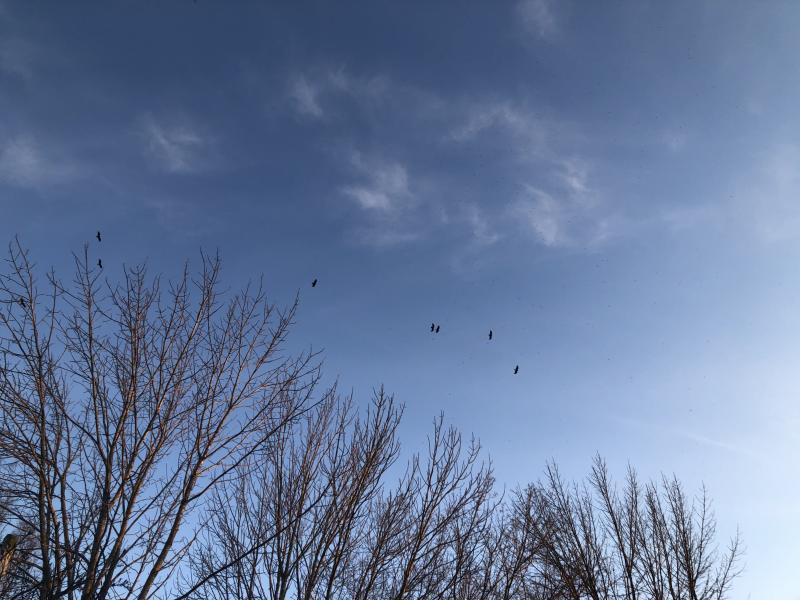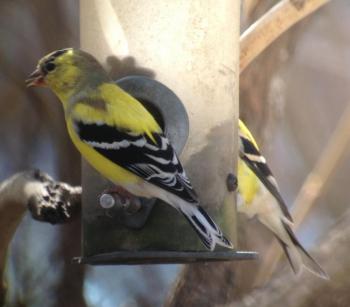Yesterday morning as we stepped into the kitchen we were captivated by the sweet, penetrating “Old Sam Peabody, Peabody, Peabody” song of a white-throated sparrow. It had arrived in our backyard after an overnight migration from somewhere south of us. We heard it, then saw it a few times over the day as it scratched around under the feeder. Its white striped head and white throat seemed particularly bold and crisp. Any female white-throat that ventured nearby would have been impressed.
We hadn’t seen a white-throated sparrow at our feeder since early January so, although some people have had them here in Maine throughout the winter, we were confident that ours was a new arrival. As we write this, there is no white-throated sparrow singing in the yard, presumably having left last night to fly north. We hope that someone awoke some place farther north in Maine to be blessed with that striking song echoing around their backyard as it had ours.
After dinner yesterday we stepped out onto the porch in that golden light of evening and looked up into the blue sky to see 10 massive turkey vultures floating in the last dying winds of the day. They seemed to be trying to assess where their best options would be for a place to spend the night. We regularly see groups of migrant turkey vultures like this over our neighborhood, their silvery flight feathers glinting in the last rays of sun. With binoculars, we can see their naked red heads craning around as they scan for tall pine trees — or, in today’s day and age, perhaps a tall cell tower — that affords room for them all to glide in and roost until the next morning.
The turkey vultures had just disappeared over the rooftops toward the river when another large bird appeared over our house. Was it an eagle? No, it was our first osprey of the year! It circled overhead, letting us gaze joyfully at it and then even blessed us with several of those wonderful screeching calls that are such a characteristic sound of spring and early summer here in Maine. We had to wonder if this was a bird that nested down along the stream below the house and was calling with joy itself after enduring many weeks of travel, perhaps from as far away as northern South America or some other distant wintering ground.
Over the weekend we heard the snappy “fee-bee” of our first eastern phoebe of the spring. Later we saw and heard several more at some other nearby spots. And we also some clouds of non-biting flies (newly hatched or do they overwinter somehow?) which is good news for insect-eaters like those newly arrived phoebes as well as newly arrived tree swallows.
That osprey had just floated out of sight when we had one more new migrant arrival in our neighborhood. This one we never actually saw but its high, thin, rapid “see-see-see” identified it as a golden-crowned kinglet. A lover of thick stands of hemlock, spruce, and balsam fir, golden-crowned kinglets can be found year-round in such places in Maine. We don’t have any of that habitat in our immediate area so on the very few occasions when we see or here one in our neighborhood, we know it is a migrant.
We have mentioned in the last few weeks about the increasing numbers of American goldfinches around. In our yard, the numbers have continued to grow, but that is only part of the story. As the numbers increase, the sound has become almost a tumult. It’s hard to say how many there are at any one time, but the trees and bushes seem to be full of male goldfinches singing simultaneously (they don’t seem to follow the rule of not singing over each other as in other birds that we wrote about last week). At the same time, the males are chasing females and each other round and round as they all sing and call. It’s quite a show, made yet even more spectacular if one can get a view of the males that are showing all sorts of crazy, carnival-like costumes as they molt from their drabber winter garb to their bright yellow and black summer plumage—yet another clue to the change of seasons in the backyard.
Jeffrey V. Wells, Ph.D., is a Fellow of the Cornell Lab of Ornithology and Vice President of Boreal Conservation for National Audubon. Dr. Wells is one of the nation's leading bird experts and conservation biologists and author of the “Birder’s Conservation Handbook.” His grandfather, the late John Chase, was a columnist for the Boothbay Register for many years. Allison Childs Wells, formerly of the Cornell Lab of Ornithology, is a senior director at the Natural Resources Council of Maine, a nonprofit membership organization working statewide to protect the nature of Maine. Both are widely published natural history writers and are the authors of the popular book, “Maine’s Favorite Birds” (Tilbury House) and “Birds of Aruba, Bonaire, and Curaçao: A Site and Field Guide,” (Cornell University Press).






























